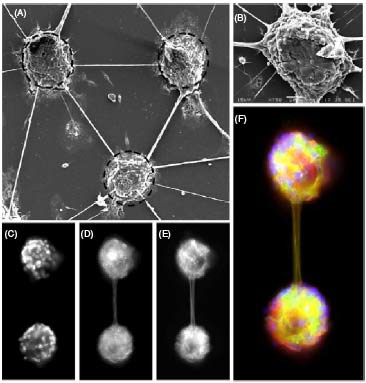Brain Chip Made With Rat Neurons

A uniform neural net of brain cells—a brain chip—has been created by a team of scientists lead by Yael Hanein of Tel Aviv University in Israel.
100-micrometer-wide bundles of nanotubes were used to get the rat neurons to form regular patterns on a sheet of quartz. The neurons bind to the nanotubes, which are placed close enough for the nerve cells' axons and dendrites to make links between cells and clusters. The electrical activity of the brain chip can be easily measured because carbon nanotubes conduct electricity.
According to Hanein, this method results in more uniform neural networks; they also last longer than other artificial networks of neurons, lasting up to eleven weeks.
Fans of science fiction writer Peter Watts will look at these new brain chips, and recognize the head cheese from his 1999 novel "Starfish":
Humans had always been able to integrate 3-D spatial information better than the machines that kept trying to replace them... Until now, apparently... "It's one of those smart gels," Ray said at last... "Head cheese. Cultured brains on a slab. The same things they've been plugging into the Net to firewall infections. (Read more about Peter Watts' head cheese)
Science marches on—but sci-fi writers were there first.
Take a look at an article on an earlier real-life version of head cheese—Rat Neurons In A Dish Now Playing Flight Simulator. Read more about how Neurons self-organise to make brain chips.
(This Science Fiction in the News story used with permission from Technovelgy.com - where science meets fiction.)
Sign up for the Live Science daily newsletter now
Get the world’s most fascinating discoveries delivered straight to your inbox.










